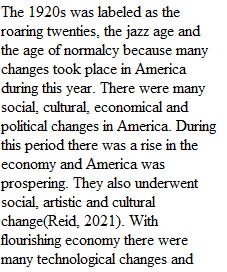


Q • Many historians have labeled the 1920s, referring to the decade as “The Roaring Twenties,” the “Jazz Age,” and the “Age of Normalcy.” Although each label implies something different, the use of any label suggests that there was a unified culture, mood or ethos in America during the 1920s. Other scholars point out that the 1920s were a decade of highly variegated cultural, social, political, and economic differences. Do you see society in the 1920s as being unified around a cultural theme? If so, what was that theme and how was it expressed? Or do you believe that the 1920s were characterized by overlapping or contrasting cultures? If so, what were those different cultures and how were they expressed? • There have been many interpretations of the New Deal put forth by politicians, historians, and political commentators: (1) Franklin D. Roosevelt believed that the New Deal was simply an extension of the Progressive Era, or a return to progressivism, where government assumes the primary regulatory role in an industrialized society. (2) Others have seen the New Deal as the beginning of the “mixed economy” or “welfare state” where government acts as a participant within the economy, often as a surrogate or supplement for private business activity. (3) Still others have described New Deal policies as “creeping socialism” or just socialism itself, and (4) still others see the New Deal as tantamount to a government bail-out for corporate America; that thanks to the New Deal, Roosevelt saved capitalism from itself. What aspects of the New Deal do you believe fall into these interpretations, and, on balance, which interpretation of the New Deal do you find most credible?
View Related Questions